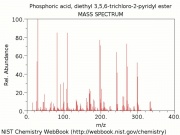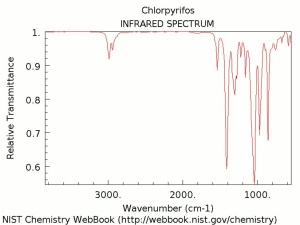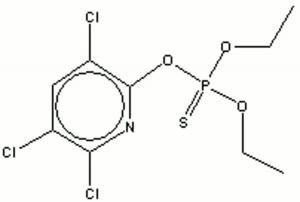Difference between revisions of "Chlorpyrifos"
Jump to navigation
Jump to search
(username removed) |
|||
| (4 intermediate revisions by 4 users not shown) | |||
| Line 1: | Line 1: | ||
| − | [[File: | + | [[File:chlorpyrifosms.jpg|thumb|Mass spectrum of chlorpyrifos]] |
== Description == | == Description == | ||
| − | Toxic, white granule crystals with a strong odor. Chlorpyrifos is an organophosphate type contact [ | + | Toxic, white granule crystals with a strong odor. Chlorpyrifos is an organophosphate type contact [[insecticide]] sold under the brand name of [[Dursban]]. Dursban is broad spectrum insecticide used to control [[cockroach|cockroaches]], chinch bugs, fleas, [[termite|termites]], ants, and ticks. It has been used in pet flea and tick collars. |
| − | + | [[[SliderGallery rightalign|chlorpyrifosir.jpg~FTIR|chlorpyrifosstr.jpg~Chemical structure]]] | |
== Synonyms and Related Terms == | == Synonyms and Related Terms == | ||
chlorpyriphosethyl; chloropyrifos (sp); O,O-diethyl O-3,5,6-trichloro-2-pyridyl phosphorothioate; Dursban [Dow]: Lorsban; Dowco 179; ENT 27311 | chlorpyriphosethyl; chloropyrifos (sp); O,O-diethyl O-3,5,6-trichloro-2-pyridyl phosphorothioate; Dursban [Dow]: Lorsban; Dowco 179; ENT 27311 | ||
| − | + | == Risks == | |
| − | == | + | * Toxic by inhalation, ingestion and skin contact. |
| + | * Corrosive to iron, copper and brass. | ||
| + | * Discolors red dyes. | ||
| + | * May leave deposits on nearby surfaces. | ||
| + | * Combustible. | ||
| + | * Cayman Chemical [https://www.caymanchem.com/msdss/21412m.pdf SDS] | ||
| + | |||
| + | == Physical and Chemical Properties == | ||
Soluble in acetone, benzene, carbon disulfide, carbon tetrachloride, chloroform, diethyl ether, methylene chloride, xylene. Insoluble in water. | Soluble in acetone, benzene, carbon disulfide, carbon tetrachloride, chloroform, diethyl ether, methylene chloride, xylene. Insoluble in water. | ||
| Line 23: | Line 30: | ||
|- | |- | ||
! scope="row"| Melting Point | ! scope="row"| Melting Point | ||
| − | | 41-42 | + | | 41-42 C |
|- | |- | ||
! scope="row"| Density | ! scope="row"| Density | ||
| − | | 1.398 | + | | 1.398 g/ml |
|- | |- | ||
! scope="row"| Molecular Weight | ! scope="row"| Molecular Weight | ||
| Line 32: | Line 39: | ||
|} | |} | ||
| − | == | + | == Resources and Citations == |
| − | |||
| − | |||
| − | |||
| − | |||
| − | |||
| − | |||
| − | |||
| − | |||
| − | |||
| − | |||
| − | |||
| − | |||
| − | |||
| − | |||
| − | |||
| − | |||
| − | |||
| − | * | + | * Random House, ''Webster's Encyclopedic Unabridged Dictionary of the English Language'', Grammercy Book, New York, 1997 |
| − | * | + | * Richard S. Lewis, ''Hawley's Condensed Chemical Dictionary'', Van Nostrand Reinhold, New York, 10th ed., 1993 |
* ''The Merck Index'', Martha Windholz (ed.), Merck Research Labs, Rahway NJ, 10th edition, 1983 | * ''The Merck Index'', Martha Windholz (ed.), Merck Research Labs, Rahway NJ, 10th edition, 1983 | ||
| − | * | + | * Lynda A. Zycherman, J.Richard Schrock, ''A Guide to Museum Pest Control'', FAIC and Association of Systematics Collections, Washington DC, 1988 |
| − | * | + | * J. Dawson, ''CCI Technical Bulletin'', 'Solving Museum Insect Problems: Chemical Control' , Canadian Conservation Institute, Ottawa, No. 15 |
| − | * | + | * Pam Hatchfield, ''Pollutants in the Museum Environment'', Archetype Press, London, 2002 |
[[Category:Materials database]] | [[Category:Materials database]] | ||
Latest revision as of 12:45, 29 May 2022
Description
Toxic, white granule crystals with a strong odor. Chlorpyrifos is an organophosphate type contact Insecticide sold under the brand name of Dursban. Dursban is broad spectrum insecticide used to control cockroaches, chinch bugs, fleas, termites, ants, and ticks. It has been used in pet flea and tick collars.
Synonyms and Related Terms
chlorpyriphosethyl; chloropyrifos (sp); O,O-diethyl O-3,5,6-trichloro-2-pyridyl phosphorothioate; Dursban [Dow]: Lorsban; Dowco 179; ENT 27311
Risks
- Toxic by inhalation, ingestion and skin contact.
- Corrosive to iron, copper and brass.
- Discolors red dyes.
- May leave deposits on nearby surfaces.
- Combustible.
- Cayman Chemical SDS
Physical and Chemical Properties
Soluble in acetone, benzene, carbon disulfide, carbon tetrachloride, chloroform, diethyl ether, methylene chloride, xylene. Insoluble in water.
| Composition | C9H11Cl3NO3PS |
|---|---|
| CAS | 2921-88-2 |
| Melting Point | 41-42 C |
| Density | 1.398 g/ml |
| Molecular Weight | mol. wt. = 350.6 |
Resources and Citations
- Random House, Webster's Encyclopedic Unabridged Dictionary of the English Language, Grammercy Book, New York, 1997
- Richard S. Lewis, Hawley's Condensed Chemical Dictionary, Van Nostrand Reinhold, New York, 10th ed., 1993
- The Merck Index, Martha Windholz (ed.), Merck Research Labs, Rahway NJ, 10th edition, 1983
- Lynda A. Zycherman, J.Richard Schrock, A Guide to Museum Pest Control, FAIC and Association of Systematics Collections, Washington DC, 1988
- J. Dawson, CCI Technical Bulletin, 'Solving Museum Insect Problems: Chemical Control' , Canadian Conservation Institute, Ottawa, No. 15
- Pam Hatchfield, Pollutants in the Museum Environment, Archetype Press, London, 2002


